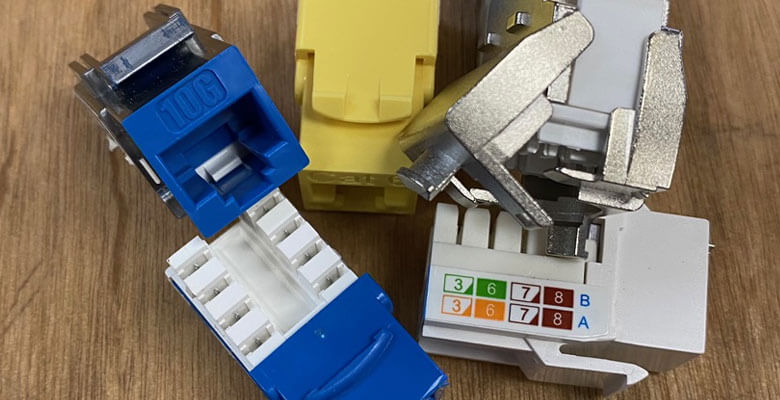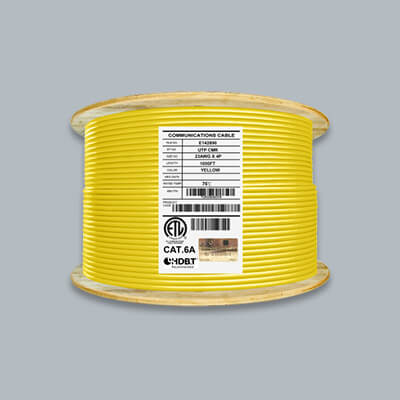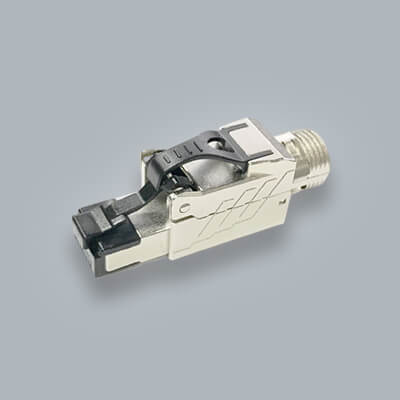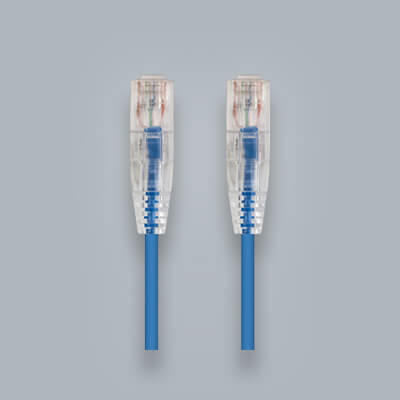How To Choose A Keystone Jack

A cable is really nothing without a connector. Whether connecting your favorite gaming console or bringing your computer up to speed an ethernet cable is paired using some type of connector. One of the most common connector types for ethernet cables are keystone jacks.
Keystone jacks are an affordable and easy to use solution for connecting various ethernet cables. In this post we will make your next installation easier on how to choose a keystone jack.
What Is A Keystone Jack?
Let's first get a better understanding of what exactly a keystone jack is. A keystone jack is a standardized plug in package for mounting low voltage electrical. It is commonly referred to as a module which is used to connect in to various keystone wall plates, surface mount boxes and patch panels. You can think of a keystone jack as a cube with many different uses. Each keystone jack has different functions for different cables. This is why you'll see keystone jacks / modules available in different types:
- Keystone Module
- Keystone Jack
- RJ45 Jack
- 6P6C 6-position 6-conductor
- 8P8C 8-position 8-conductor
- F Connector
- RCA Jack
- USB Jack
- Banana Connectors
A keystone jack has a type of ethernet port in the front of it. The opening of the jack has many pins inside which are made up of microns of gold. The opening of the keystone jacks are there to accept various modular plugs which are typically unshielded or shielded RJ45 plugs. The kind that are used to connect to ethernet cables such as Cat5e, Cat6, Cat6A and above. These types of category cables come in bulk cable form or patch cables.
On the back end of the keystone jack is a punch down area for the wires in your cables. The wires are inserted in to the contact areas on the back end to create a connection with your ethernet cable. Make sure to follow the correct wiring scheme: t568A or t568B. Once the wires are punched down and terminated using a punchdown tool then you can connect your keystone jack in to one of many different accessories.
Now that we have a good grasp of what is a keystone jack and you're in the market for one lets get in to some buying advice.
What To Know When Choosing A Keystone Jack
- Pick a category: Making sure that the category of your keystone jack matches up with your cable is important for performance capabilities. This also ensures that the wires can fit in to the contact area.
- Shielded or Unshielded: Depending on your installation environment will determine what type of keystone jack you want to use.
- 90° or 180°: Jacks come designed with different degrees. The degrees on the jack have to do with the way the wires and cable will be inserted in to the jack.
- Connecting your jack: Now that your cable is properly terminated and your wires are punched down it's time to plug in your jack.
Ready to buy a keystone jack? Shop our wide selection of the best keystone jacks for any type of installation.
Keystone Jacks: What Category To Use
One of the first thing you want to do when shopping for keystone jack is to figure out what category of cable I have or am going to using. The easiest thing to do here is to match up your cable category to the category of the plug. This can be Cat5e, Cat6, Cat6A or even Cat8. By matching up the type you ensure that your cable will have the opportunity to perform to its capabilities and spec. This also makes sure that the wires in the cable can fit in to the contact area of the keystone module. It's important to point out here that some categories are backwards compatible with each other. Cat6 cables can be used with Cat5e jacks and Cat5e cables can be used with Cat6 jacks. For Cat6A and above we don't recommend to use the cable on lower category plugs. For example using a Cat8 cable on a Cat6A or Cat5e jack. As well as a Cat6A cable on a Cat5e or Cat6 jack.
Shielded vs. Unshielded Keystone Jacks
Shielded

Unshielded

Choosing the structure type of your keystone jack has to do with your environment. For the majority of installations the most popular choice is going to be an unshielded keystone jack. This is for everyday use in areas where there is no EMI present. Locations such as homes and commercial buildings with no EMI. Unshielded keystone jacks come as a plastic core making is suitable for many different installations. When there is Electromagnetic Interference in your location you want to go with shielded keystone jacks. The shielding on keystone jacks is usually a die cast aluminum and is great for protecting your network from signal interference. For more information on why areas might have EMI check out our blog on everything you need to know about shielded cable.
When using a shielded cable it's important that you keep your whole channel shielded to see the benefits of the shield inside the cable. This ensures that every link in your channel will be protected from EMI. A good rule of thumb is to follow the structure type of ethernet cable you are using when deciding which keystone jack to use.
90° or 180° Keystone Jacks
90°

180°

Keystone jacks come in a couple different design types. The two you will come across is 90 degree and 180 degree. This has to do with the design of the back end of the keystone module. Since the front of the jack is standardized to fit many accessories, the back end can be different for various installs. Choosing the best angle of keystone comes down to where you are installing it and preference. The majority of keystone jacks you use will be able to terminate straight in to the jack. So choosing either angle will come down to preference.
Sometimes the cap on the 180° jack will have the opening at the top so your cable will have to come in from the top. This would be a good choice if your installing in to the back of a patch panel situated against a wall
Whatever design you choose note that there is no speed differences between the two angles.
Where To Connect Your Keystone Jack?
The final step you want to do is to pick out your cable accessories. Plan out your cable runs before hand so you know where you are running the cable and where the cable is going. Once you figure this out you can decide on the type of accessories that you will need.
The types of accessories that can be connected with a keystone jack are:
- Wall Plates
- Patch Panels
- Surface Mount Boxes
Some of the most popular uses for keystone jacks are to plug them in to a wall plate / face plate and patch panels. Keystone jacks are designed to easily snap in to these accessories. A wall plate is a great accessory for adding ethernet connections to various rooms, cubicles and buildings. They are simple to mount on the wall or raceway and are cost effective.
Patch panels are great for centralizing your network in one location. These are often seen in server closets or server rooms. The are typically designed with 12 to 48 ports. You do not have to use all the port in a wall plate. You are connecting to the keystone jack then that is connected to the patch panel.
A surface mount box is a portable device that is easily mounted to a wall or furniture. It can house anywhere from 1 to 2 keystone jacks depending on the size of the box. They are great for adding additional ethernet connections when needed.
Final Thoughts
Keystone jacks can be one of the key components to a network build. They are lightweight and available in many different types. No matter where you are running your ethernet cable there is a keystone jack for you.





